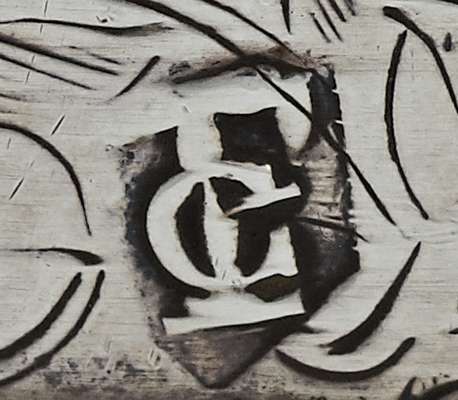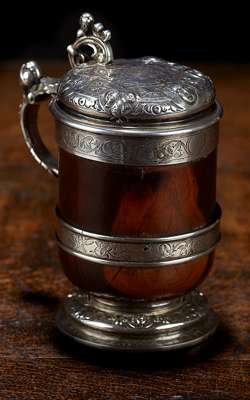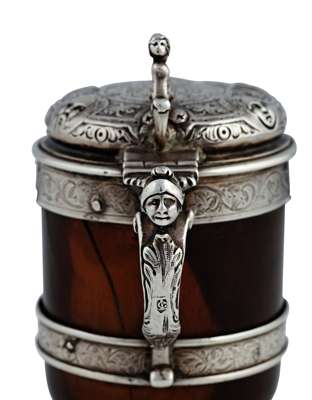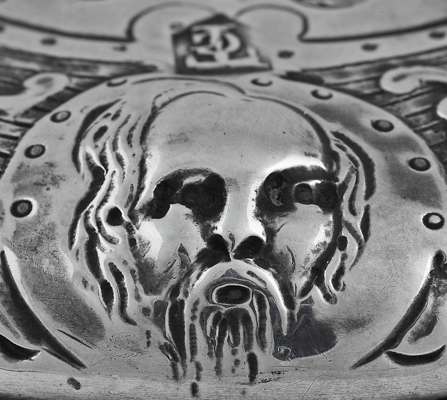
Lot 103

A rare mid 17th century silver mounted wooden tankard


















Auction: 16 August 2011 at 12:00 BST
Description
Thomas Cleghorn of Edinburgh, circa 1640, marked TC (conjoined) five times, the straight sided laburnum body silver mounted, the upper rim engraved with trailing foliage and flower heads, the lower girdle similarly engraved with trailing flowerheads rising from primitive angel figure, the two rims joined by an S scroll handle with acanthus leaf and figural thumbpiece, the hinged cover with foliate scroll thumb piece and embossed with a border of three male masks flanking panels of fruit, the centre with engraved armorial, the whole resting on a simple domed and socle foot with mask, fruit and S scroll decoration and engraved 'OMNE SOLUM FORTI PATRIA 1610'
Dimensions
15cm high (overall), rim 7.8cm diameter, foot 8cm diameter
Footnote
Heraldry: The motto engraved to the foot rim appears to be for BALFOUR.
The later engraved armorial to the cover is for Prince George, from 1801-1811 when he was Prince of Wales, and 1811-1820 when he was Prince Regent, before succeeding to the throne as King George IV in 1820.
Note: This tankard appears to form a 'missing link' between the earliest of Scottish drinking vessels; the mazers, and what would become the standard tankard / mugs of the later 17th century onwards.
The wooden body mounted with simple bands of decorated silver is very reminiscent of the engraved rims of mazers and indeed the decoration itself is directly comparable, with engraved trailing foliage from an angel-like figure.
The decoration to the cover however is obviously of a later style (contemporary with the piece) than that noted on the mazers, but does have comparables in the early Scottish survival, most notably with the ceremonial trumpets. This can be seen on the flared bell sections where similarly styled cherub masks are standard.
Although only marked with maker's marks, it has been commented that this may date to when Thomas Cleghorn was Deacon. This would also back up the date as circa 1640 as this is the first time he held the position.
It has been considered that the (later) Royal arms engraved to the cover may have connections with the Royal visit of King George IV to Scotland, when such a large part of Scotland became interested in their history and past once again. It was not uncommon to see relics of the past restored for use, display etc, whether it be tartan and kilts, swords or artworks. A tempting case has been muted that this cup may form one of the pair given to King George by Walter Scott for use at the ceremonial closing dinner for his state visit.
While this first sounds fanciful, it is noted that 'the goblets which the King would drink were antique, two centuries old', this time line would certainly fit with the original manufacture and their adornment with the Royal arms could easily be explained.
While this is only circumstantial evidence, it does add a colourful thought to the full history of the piece.
References: For a full account fo the King's visit and description of the closing banquet see 'The Kings Jaunt, George IV in Scotland, 1822' John Prebble

















